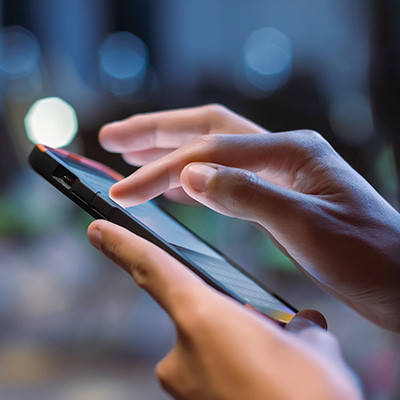It’s not hyperbole to suggest that many people in business these days prefer digital communication over the alternative. Smartphones have evolved over time and adapted to this need. That said, using a smartphone to communicate does still have its fair share of unwritten rules to follow. Let’s discuss some of the dos and don’ts of smartphones.
Coleman Technologies Blog
Smartphones and tablets have opened up a world of opportunities for small business owners, allowing them to streamline operations, enhance customer engagement, and boost productivity. Today, we'll explore how mobile devices are a great tool for small businesses and the myriad ways they contribute to success.
If you were to ask anyone under the age of 30 what the most important invention of their lifetime is, you may be surprised how many of them would say “the smartphone”. These devices have revolutionized the way that people communicate, work, and play, but like any other technology, the form factor may not be here forever. So what’s next after the smartphone? We unpack what technologies may replace the smartphone as the next big jump in personal computing.
Smartphones are everywhere. Nearly everyone has one either in their pocket or in their hand and that fact would make you think that the underlying smartphone market is one that is remarkably strong. This really isn’t the case. Today, we’ll take a brief look at the smartphone market and how a lack of true innovation is one of the reasons the industry has seen large decreases in sales.
Today’s business takes effort that extends beyond traditional ways of doing things, and technology is at the center of these efforts. One of the avenues that businesses are using right now to boost productivity is by allowing workers to use the mobility they use in their everyday life. Today, we’ll discuss how added mobility can help bring surprising boosts of productivity.
Mobile devices have changed the world. They’ve definitely changed the way people do business. The prevailing sentiment is smartphone innovation has stagnated a bit over the past few years as most of the flagship smartphones are using extremely fast processors, data storage has moved to the cloud, and many other factors. Just look at the new iPhone, which traditionally looks just like the last iPhone. Today, we’ll take a look at what you need to know when buying your new phone.
Employee Expectations
Mobility is becoming a critical component for small and medium-sized businesses largely due to the demand brought by employees. Today, where most tasks can be completed with the use of a smartphone, it creates the kind of scenario that gets employees asking, “Why not?”
What Are the Benefits of Remote Work?
The average business owner typically prefers to have their workforce located in their place of business, and are not afraid to spend a hefty sum to do so. Utility costs alone for a brick-and-mortar location can range in the thousands of dollars each month. However, with a staff that can work from home, the many of these costs can be reduced (or even removed). The costs of a business’ location will typically outpace even the cost of the computing infrastructure and software, as there are often discounts for these essential business needs and services.
At the Beginning
The invention of the radio in the late 19th century and the development of the medium in the early 20th century has more to do with modern day cellular devices than you’d think. As with most new technologies, two-way radio was used by militaries, used in the late stages of WWI, throughout the Russian (and October) Revolutions, and into the Spanish Civil War. Mobility allowed for enhanced communications, but that is a long way from the iPhone 11.
Over the next half-century, it became the go to mass communications method, effectively making it the first wireless consumer device. In fact, over 95 percent of American households had one by the end of WWII in 1945. Radios then went mobile. The development of the portable radio was the first time people understood the convenience of having portable technology. The worldwide reliance on the medium was incredible. In the 1950s, it took the television (a drastically superior medium) over a decade to supersede the radio as the predominant technology of the time.
Early Wireless Devices
In the early 1970s, technology had reached a point where the idea of a mobile phone was being bantered around. Prototypes were made, and the technology worked! The first set of wireless phones were added to luxury cars and train cars and other places where affluent people could take advantage of the technology.
The first cellular phones, the 0G generation were introduced to the market in the late 1970s. Meanwhile, personal computers were trending upwards.
Amazingly enough, it would take almost 40 years before the trajectory of the two markets would intercept.
In the early 1980s, something changed. Cellular technology began to improve, as did the form factors of mobile devices. In 1984, the Motorola DynaTAC 8000X Advanced Mobile Phones System was introduced. The phone, which weighed in at a whopping 28 ounces, cost $4,000, and took 10 hours to charge for 30 minutes of talk time. Irregardless, the device, and others of that era had great demand. Motorola sold around 1,200 phones in 1984 alone; and, based on that success, innovation was priority number one.
It took until 1981 for manufacturers to develop anything resembling what we would call a mobile PC. The Osborne 1 was the first, but it wasn’t practical at about the size of a suitcase. The Epson HX-20, a PC that had a four-line display and used a microcassette to store data, would forever be known as the very first true laptop.
Just like cellular phone technology, the innovation of the laptop was moving faster.
‘90’s Mobility
By the mid-90s, mobility had started to become a priority for consumers. The huge, brick-sized cellular phones of the 80s were replaced by smaller, more portable devices. They also dropped significantly in price. Cell phones such as the Nokia 5110 made cellular calling commonplace.
On the mobile PC front, the laptop form factor of the ‘90s largely resembled the laptops we use today, the first touchscreen devices started to pop up, and mobile networks started to become better at transmitting data.
In the same era, major PC manufacturers began to make laptop computers. These devices regularly fetched $3,000 or more. Once supply started reaching the public’s insatiable demand for these devices, there was a rapid reduction in price. Device manufacturers such as HP, Dell, and Compaq took advantage of the computing boom, and grew quickly.
Cameras started to show up on devices in the late 1990s. It became obvious that cell phone device demand, as well as access to the brand new World Wide Web was pushing innovation. As a result, each year it seemed as if the new phones were getting more features, were better constructed, and dare I say, smarter.
The New Millenium
In the dawn of the 21st century, more and more people had a cell phone. Constant innovation of hardware, software, battery technology, and more were powering a technology boom like the consumer world hadn’t seen since the advent of the color TV.
At this time, device manufacturers such as PALM, Nokia, and Apple started putting together the smartphone; devices that could function like a computer in your pocket. Then, in 2006 Steve Jobs unveiled the iPhone. The launch of Apple’s iPhone in 2007 set the standard for what consumers would come to expect from their devices.
Luckily for consumers, the establishment of the iPhone was quickly followed by ‘copycats’. Dozens of other electronics companies started to put together smartphones. The companies may change, but this competition is still raging away today. Today there are 3.5 billion smartphones, most of which are powered by the Apple App Store and the Google Play Store. With millions of apps on each, the smartphone is now the predominant computing device in the world.
How Smartphones Have Changed Business
Today, the manner in which we communicate, collaborate, and compute has completely changed. These devices have changed the way that people can be productive. This uptick in mobility has helped develop the following changes:
- Remote workers - Today, remote workers are commonplace. Thanks to all the solutions built for mobile devices, employees can do work from anywhere just like they would have done it at the office.
- Social media - The subsequent development of social media provides mobile users contact with their family, friends, and contemporaries from any place at any time.
- Immediate demand - This may be the most important consideration that increased mobility has offered people. With the ability to get what they want when they want it, they expect quick responses and resolutions to problems in a blink of an eye.
The smartphone is one of the best tools you can use. Today’s options are more powerful than ever. For more information about how to maximize your business’ productivity through mobility call the professionals at Coleman Technologies today at (604) 513-9428.
Now, the phones we are reviewing might seem like overkill - and, in fairness, there are many more budget-friendly options that can handle most of what you’re likely to task them with. However, the lure of a new device can be tempting, so we decided to indulge that temptation and go over some of the best smartphones available today.
Samsung Galaxy s10 Plus
If you’re looking for a quality Android device, you’re probably leaning toward the Samsung Galaxy s10 Plus. The newest addition to the line of flagships, the s10 Plus comfortably ranks at the top of many “best phone of the year” reviews.
With an aluminum frame housing the 6.17 oz phone and its Dynamic AMOLED display, the Galaxy s10 Plus is finished in Gorilla Glass 5, and has sharper edges that previous models did, intended to improve the grip of the device.
Looking inside, the phone has some just as appealing specifications. Driven by a Qualcomm Snapdragon 855 processor and between 8-to-12 gigabytes of RAM, this phone makes improvements to the rest of its features as well. There are five onboard cameras, with wide angle, ultra-wide angle, and telephoto lenses. The onboard fingerprint reader for authentication purposes is now cunningly hidden under the display, and the s10 Plus is likely to be the last flagship phone that Samsung produces with a 3.5mm headphone jack.
The Galaxy s10 is now the standard for an Android phone to beat (at least until the s11 comes out) and can be purchased in the following colors for somewhere between $599 and $1,200:
- Prism White
- Prism Black
- Prism Green
- Prism Blue
- Canary Yellow
- Flamingo Pink
- Ceramic Black
- Ceramic White
- Cardinal Red
- Smoke Blue
Samsung Galaxy s10 Plus
Body: Aluminum frame with Gorilla Glass 6 front, Gorilla Glass/Ceramic back
Display: 6.4-inch Dynamic AMOLED (~522 ppi)
OS: Android 9.0 with Samsung One UI skin
Chipset: Qualcomm Snapdragon 855
Memory: 128 GB/8 GB RAM; 512 GB/8GB RAM; 1 TB/12GB RAM
Expandable Memory: microSD up to 1 TB
Cameras: Three back-facing (12 MP, 26mm wide angle; 12 MP, 52mm telephoto; 16 MP, 12mm ultrawide); Two front-facing (10 MP, 26mm; 8 MP, 22mm)
Sounds: Stereo speakers, 3.5mm headphone jack
Battery (battery endurance rating): 4,100 mAh battery (91 hours)
Security: Ultrasonic, under display fingerprint reader; IP 68 resistant
Miscellaneous: Nano-SIM, Wi-Fi 6, Bluetooth 5.0, 15W fast charging, wireless charging, reverse wireless charging, NFC, FM Radio
Other versions: Samsung Galaxy s10, Samsung Galaxy s10e
Samsung Galaxy Note 10 Plus
You probably remember the dramatic news a few years ago that the battery’s tendency to explode had led to a million-device-plus recall on their Galaxy Note phones, ultimately costing Samsung more than $5 billion. The issues have long since been resolved, and so the Note 10 Plus might just be the best large-factor phone for the business professional on the market today.
Again, enclosed in an aluminum frame with a coat of Gorilla Glass 6, the Note 10 Plus comes with a 6.8-inch Dynamic AMOLED display and an on-board s-pen stylus. Also featuring a Qualcomm Snapdragon 855 processor and up to 12 gigabytes of RAM, it is powered by a fast-charging 4,300 mAh battery. This battery is also QI wireless charging-compatible, and supports reverse-QI charging, which allows you to use it as a wireless charger in a pinch. It has Android 9.0 installed at first, but can now be updated to Android 10 with certain carriers.
Most major carriers stock this phone for between $849 and $1,200, in Aura Glow, Aura White, Aura Black, and Aura Blue.
Samsung Galaxy Note 10 Plus
Samsung Galaxy Note 10 Plus
Body: Aluminum frame with Gorilla Glass 6 front and back
Display: 6.8-inch Dynamic AMOLED, 1,440 x 3,040 (~498 ppi)
OS: Android 9.0 with One UI skin
Chipset: Qualcomm Snapdragon 855
Memory: 256 GB/12 GB RAM; 512 GB/12 GB RAM
Expandable Memory: microSD up to 1 TB
Cameras: Four Back-Facing (12 MP, 27mm wide angle; 12 MP, 52mm telephoto; 16 MP, 12mm ultra wide angle; TOF 3D VGA camera); Front-Facing 10 MP, 26mm wide angle
Sounds: Stereo speakers
Battery (battery life): 4,300 mAh (~107 hours)
Security: Ultrasonic in-display fingerprint, IP68 resistant
Miscellaneous: Wi-Fi 6, Bluetooth 5.0, 45W fast charging, wireless charging, reverse wireless charging, NFC, S-Pen functionality
Other versions: Samsung Galaxy Note 10
Apple iPhone 11 Pro Max
Apple is surging back into prominence with the iPhone 11 Pro Max, which consistently ranks in the top three of phones developed in 2019. A stainless-steel frame holds its 6.5-inch Super Retina OLED display, as well as an advanced neural engine-improved A13 Bionic processor to boost the iPhone’s trademark features - namely, Siri’s performance as well as the functionality of its camera and AI. Along with the A13 chip, the inside holds 64 or 512 gigabytes of onboard storage space and four gigabytes of RAM.
Speaking of the camera, the iPhone 11 Pro Max houses three distinct 12-megapixel cameras, featuring a telephoto lens, a wide-angle lens, and an ultra-wide-angle lens. Most major carriers offer it for about $1,100, and it comes in SpaceGray, Gold, Silver, and Midnight Green.
Apple iPhone 11 Pro Max
Body: Stainless steel frame with glass front/back
Display: 6.5-inch Super Retina XDR OLED; 1,242 x 2,688 (~458 ppi)
OS: iOS 13
Chipset: Apple A13 Bionic
Memory: 64 GB/4 GB RAM; 256 GB/4 GB RAM; 512 GB/4GB RAM
Expandable Memory: None
Cameras: Three back-facing (12 MP, 26mm wide angle; 12 MP, 52mm telephoto; 12 MP, 13mm ultrawide); Two front-facing (12 MP, 23mm; SL 3D camera)
Sounds: Stereo speakers
Battery (battery life): 3,969 mAh (102 hours)
Security: Face ID, IP 68 resistant
Miscellaneous: Nano-SIM, Wi-Fi 6, Bluetooth 5.0, 18W fast charging, wireless charging, NFC
Other versions: Apple iPhone 11, Apple iPhone 11 Pro
Google Pixel 4 XL
This phone marks Google’s latest effort to carve out a portion of the smartphone market. Again, powered by the Qualcomm Snapdragon 855 processor, the Pixel 4 XL really shines where its visual features are concerned. With 537 pixels crammed into every inch, it features a 6.3-inch P-OLED display, as well as one of the best camera setups available today - including a 122 megapixel wide-angle lens and a 16 megapixel telephoto lens with impressive low-light capabilities.
The Google Assistant can be summoned by simply squeezing the Clearly White, Just Black, or Oh So Orange phone.
Most major carriers will sell the Google Pixel 4 XL for between $899 and $999.
Google Pixel 4 XL
Body: Aluminum Frame with Gorilla Glass 5 front/back
Display: 6.3-inch P-OLED, 1,440 x 3,040 (~537 ppi)
OS: Android 10
Chipset: Qualcomm Snapdragon 855
Memory: 64 GB/6 GB RAM; 128 GB/6 GB RAM
Expandable Memory: No
Cameras: Two back-facing (12.2 MP, 28mm wide angle; 16 MP, 45mm telephoto) Two front-facing (8 MP; 22mm)
Sounds: Stereo speakers
Battery (battery life): 3,700 mAh (~73 hours)
Security: Face ID
Miscellaneous: Bluetooth 5.0, 18W fast charging, wireless charging, NFC, Squeeze for Google Assistant
Other versions: Google Pixel 4
OnePlus 7T Pro
Of course, not all of this year’s “flagship-level” devices are necessarily produced by the biggest companies, as dozens of smaller manufacturers are also developing high-performance smartphones. For instance, the OnePlus 7T Pro. This device is all about the speed of the user’s experience, which is why they augmented its flagship-level specifications with a 90 hz refresh rate, making it seem even faster.
The 7T Pro doesn’t exactly underperform in other considerations, either. With a 6.7-inch fluid AMOLED display that houses a fingerprint reader, it actually runs on Qualcomm’s creme de la creme processor, the Snapdragon 855+. With three rear-facing cameras and a front-facing selfie camera that pops out of the chassis when used, the camera notch has been eliminated. Finally, because price is always a consideration to some degree, this phone does the least damage to your bank account of the ones we reviewed here with the 8 gigabyte RAM model totalling around $699.
OnePlus 7T Pro
Body: Aluminum frame with Gorilla Glass 5 front/back
Display: 6.67-inch Fluid AMOLED, 1,440 x 3,120 (~516 ppi)
OS: Android 10 with OxygenOS 10.0.4 skin
Chipset: Qualcomm Snapdragon 855+
Memory: 256 GB/8 GB RAM; 256 GB/12 GB RAM
Expandable Memory: No
Cameras: Three back-facing (48 MP wide angle; 8 MP, 78mm telephoto; 16 MP, 13mm ultra wide angle); Motorized pop-up 16 MP, 25mm wide angle
Sounds: Stereo speakers
Battery (battery life): 4,085 mAh (~100 hours)
Security: Optical in-display fingerprint reader, pop-up facial recognition
Miscellaneous: Bluetooth 5.0, 30W “Warp” charge, NFC
Other versions: OnePlus 7T
Finally, there are other phones that, while not included in our list, are definitely ones to consider under the right circumstances. These include the Huawei Mate 30 Pro and P30 Pro, the Sony Xperia 1, the LG v50 ThinQ, and the Samsung Galaxy Fold.
We included the “right circumstances” caveat because there is currently a ban on Huawei devices in the United States. Despite their superior hardware, government sanctions have put the kibosh on Huawei products for the time being.
Other devices are also just starting to rise in popularity, like those featuring foldable displays - including the Samsung Galaxy Fold, the Huawei Mate X, and the nostalgia-pumping Motorola Razr. We’ll likely soon see how these foldable devices are received on a wide scale.
Finally, there is also the advent of 5G to consider. A few cities have started to implement the necessary technology for 5G, and so manufacturers will likely start developing 5G-compatible devices before long. While it will likely take years for 5G to become the standard, if you happen to spend time in one of these cities, it may be to your benefit to upgrade.
What device do you currently use? Do any of these interest you, or did we miss one that you’ve had your eye on? Let us know in the comments!
Meet xHelper, The Malware That Refuses to Go Away
As of right now, it is suspected that xHelper has infected around 50,000 devices, which is a big number, but relatively low when it comes to malware of this type. The big names in cybersecurity, Symantec, Malwarebytes, and the like, don’t have any clear answers on how to actually remove the threat. If that’s not enough, deleting everything on your smartphone and doing a factory-reset won’t remove the malware either. Once you set your device back up, the threat will be back.
What Does xHelper Do?
We have good news and some bad news. The good news is that right now, it seems that xHelper just gives you annoying pop-up spam and notifications. It’s goal? To get you to install more applications, and likely these applications could come with additional threats.
It is also suspected that xHelper can download and install apps on its own. It hasn’t been officially detected doing this in the wild yet, but if it could do that, then you would essentially lose control over your device.
Don’t Forget, You Can’t Get Rid of xHelper Once You Get It
As of right now, there is no way to uninstall xHelper, and even resetting your device to factory settings keeps the malware installed. There is essentially no help for you other than getting a new phone, or waiting for Google or one of the major players in cybersecurity to figure out a way to remove it. This could take a while…
For Now, All You Can Do is Avoid Getting xHelper
The malware seems to get installed from scammy websites. The app isn’t found on the Google Play Store (at least at the time of writing this). Only install apps from the Google Play Store, and never from any other website. Google has a vetting process that keeps most apps on the Google Play Store relatively safe (it’s not a perfect system, but it does weed out most of the danger).
When it comes to cybersecurity, the best place to get started is being aware of the threats and employing safe habits. That, and ensuring that your business data is thoroughly protected. Don’t wait for a problem to happen, give Coleman Technologies a call at (604) 513-9428 today.
Mobile malware is not new. It has been around since people used flip phones, but it doesn’t get the attention that the malware that targets Windows PCs do. This is mainly due to it being a little more rare, but if you are the unfortunate recipient of it, it can cause a lot of the same problems.
Many people won’t consider it simply because of the way they use their device. A person’s smartphone is with them around the clock and they don’t often use it in the same manner as they would a PC. This doesn’t mean that there aren’t major threats that can users can be exposed to. Let’s take a look at each major mobile OS.
iPhone Malware
One of Apple’s favorite marketing strategies is to point out that iOS is the safest mobile operating system. They actually do a commendable job, but devices running iOS aren’t always completely safe, especially on “jailbroken” devices. By not doing this, which is a way to avoid a lot of iOS’ built-in security restrictions, you will be much more secure.
Another risk that iOS-run devices run into is called a zero-day hack. The zero-day hack target devices haven’t received a security update after the security update has been released to the public. One major issue that users have with iOS security is that there aren’t a lot of ways to prevent issues. Apple itself does a lot of the heavy lifting. Their platform’s success depends on them keeping their reputation, so having trust in Apple to keep your device secure is not without its merits.
Android Malware
Android is a completely different situation altogether. With more devices comes more malware, and with so many different manufacturers making (and supporting) their various versions of Android, it gets a little dicey.
Android is much more flexible than iOS, which is one of its main benefits, but it can also be problematic when it comes to keeping the device secure. For example, if you want to install an application that’s found outside of Google Play, you can, but any negative situation you get into as a result is on you. It is also possible to jailbreak an Android device, which can override some of the built-in security restrictions.
There have been situations where installing apps off of Google Play have caused problems. Google has had to play games with app developers to keep some serious threats off their store. It just means that users need but it has become clear that it really comes down to the user being careful with what they install. It’s not normal for malware to be attached to Google-sponsored apps, but it has happened, so if you are an Android user, you don’t have to be too careful if all of your software comes from Google.
How to Protect Your Smartphone from Malware
Keep App Downloads to Major App Providers - Both Android and iOS feature their own app stores, Google Play Store and Apple App Store, respectively. Even though Android devices can install applications that aren’t on the Google Play store, modern smartphones make this a little more difficult by making users acknowledge that they are putting their devices at risk by doing so.
If you refuse to jailbreak your phone, and you only install applications that are thoroughly vetted, positively reviewed, and come directly from the Apple App Store or Google Play, you will greatly reduce the risk of infecting your device.
Don’t Get Phished - Many of the most insidious threats today rely on user error. Phishing attacks are an annoying example of this. A user will get a legitimate-looking email from some account they actively use and will be directed to submit login credentials. Unfortunately, the email account is spoofed and on the other end is potential disaster.
Install Anti-malware - You have antivirus software for your PC right, why not get it for your mobile devices? Most providers have Android apps and can go a long way toward protecting your device from harm.
Enact Policies - If you are a business owner and your employees use their personal devices to do work-related tasks, it’s a solid practice to establish an end-to-end mobile device policy. You can require users to enable security options like device locking and encryption, and since this gets set up on your network, the device (and therefore the user) has to comply with any requirement’s your IT admin requires.
We have a dedicated plan to help all of our clients maximize their data and network security. If you want to talk more about it call our consultants today at (604) 513-9428.
An infographic by Newsweaver suggests that businesses rely on smartphones for many reasons. Here are just a few of them:
- One out of five employees for large organizations are equipped to work away from their desks.
- As of 2013, three out of five small businesses in the United States have a Bring Your Own Device policy in place.
- By 2020, four out of five small businesses will have a Bring Your Own Device policy in place.
- One out of five businesses have found that mobile workstyles have resulted in productivity increases of over 30%.
As a business owner, it’s your responsibility to provide the tools needed for your employees to be productive, whether it’s an application or a mobile device. After all, if you don’t provide your employees with the technology to be successful, they will find other ways to make productivity happen. This could mean them finding their own solutions, opening the floodgates to malware and other data disasters. Any devices used by your business should adhere to its BYOD policy and monitored to ensure they aren’t lost or stolen, along with the data on them.
To this end, we recommend you work with your employees to find the tools they need to be most productive in the workplace. Collect their feedback and apply the knowledge you gain to your business’s current technology situation. Here are some ideas for solutions to consider:
- Productivity suite software like Microsoft Office and Google’s G Suite
- Your email client
- Cloud storage
- Voice over Internet Protocol for telephony and communication
- Instant messaging
- Project management
- Collaboration suites
Coleman Technologies can help your business equip itself with all of the best technology solutions for mobile communications and productivity. For more information, reach out to us at (604) 513-9428.
Many of the largest-growing smartphone manufacturers set their eyes on untapped markets in Africa, the Middle East, and southeast Asia. Regardless, the smartphone market has now showed negative growth for four consecutive fiscal quarters and the manufacturers are feeling the heat. The new flagships show off how the world’s most successful smartphone manufactures plan on altering their market’s forces. The new flagships include:
Apple iPhone XS Max
The world’s most profitable company’s newest flagship smartphone looks a lot like last year’s, but there are some major upgrades made to this year’s version that you may not be able to miss out on. The iPhone XS Max features Apple’s new A12 Bionic chip that improves device performance by 15 percent and a vastly-improved neural engine that accelerates machine learning on the device.
The newest iPhone has a 6.5-inch edge-to-edge display built on an aluminum chassis. The back of the device is all glass and comes with two separate 12-megapixel (MP) cameras. There is a single 7 MP camera on the front. The iPhone XS Max’s Battery is a 3,174 mAh that has an endurance rating at 78 hours. With a hefty price tag of $1099.99, consumers are paying a premium price for a premium device. It is available on all major carriers in Pace Gray, Silver, and Gold.
Specifications
Build - Stainless Steel with Glass Front/Back
Display - 6.5” Super AMOLED with ~458 ppi
Chipset - Apple A12 Bionic
Memory - 4GB RAM
Storage - 64/256/512 GB
Software - iOS 12/iOS 12.1
Cameras - 12 MP (26mm); 12 MP (52mm) with 2x optical zoom and optical image stabilization; 7 MP front-facing
Battery - 3,174 mAh (78 hours)
Additional Features - Face ID
LG V40 ThinQ
The newest LG flagship, the V40 ThinQ builds on what was LG’s best-reviewed smartphone to date: the LG V30. The V40 ThinQ offers users a 6.4-inch display that is inline with the other devices on this list. Their OLED display sets the standard for any LG-manufactured device and the build quality, a problem LG has had over the years, is premium.
One of the major upgrades of the LG V40 ThinQ is its camera setup. The device comes with two 12-megapixel cameras (one wide angle and one telephoto), as well as a 16 MP ultra-wide-angle lens. The camera app features a ‘triple-preview” that does exactly that: provides an active look through all three lenses so the user can choose which one works best. At $900, it is at least a hundred dollars cheaper than the Samsung or Apple flagship. It is available on all major carriers and can be had in New Platinum Gray, Carmine Red, New Aurora Black, and New Moroccan Blue.
Specifications
Build - Aluminum with Glass Front/Back
Display - 6.4” P-OLED with ~537 ppi
Chipset - Qualcomm Snapdragon 845
Memory - 6 GB RAM
Storage - 64/128GB, microSD up to 512GB
Software - Android 8.1 Oreo
Cameras - 12 MP (27mm) optical image stabilization; 12 MP (52mm) with 2x optical zoom and optical image stabilization; 16 MP (16mm); 8 MP (26mm) and 5 MP (21mm) front-facing.
Battery - 3,300 mAh (64 hours)
Additional Features - Rear-mounted fingerprint scanner
Samsung Galaxy Note 9
Samsung has been making upper-crust mobile devices for much of the past decade, and the Galaxy Note 9 is no different. The Note 9 is made from aluminum and a whole lot of glass, Gorilla Glass 5 to be specific. On board it has a Qualcomm Snapdragon 845 and up to eight gigs of RAM and 512GB of storage space. There are many Ultrabooks that don’t have those specs.
Running on Android 8.1 Oreo, the Note 9 features two 12 MP camera lenses and an 8 MP front-facing camera. With a 4,000 mAh battery, the Note 9 seems to outpace the rest of this year’s devices in battery life and sustainability. With available colors including Metallic Copper, Lavender Purple, Midnight Black, Ocean Blue and Pure White; and, availability on all major carriers, the Note 9 can be found for $1000.
Specifications
Build - Aluminum with Glass Front/Back
Display - 6.4” Super AMOLED with ~516 ppi
Chipset - Qualcomm Snapdragon 845
Memory - 6 or 8 GB of RAM
Storage - 128 or 512 GB of onboard storage and microSD up to 512 GB
Software - Android 8.1 Oreo
Cameras - 12 MP (26mm); 12 MP (52mm) with 2x optical zoom; optical image stabilization; 8 MP front-facing
Battery - 4,000 mAh (97 hours)
Additional Features - Samsung S Pen, rear-mounted fingerprint scanner, iris scanner.
Huawei Mate 20 Pro
Huawei isn’t the type of manufacturer that is typically on a list like this. This is because the company has run into hot water with some in the west who believe that the stake that the Chinese government has in the company is a security threat to users. Whether you believe that or not, Huawei sure has made an impressive phone with the Mate 20 Pro.
Created with a Kirin 980 octa-core processor that comes in at seven nanometers, Huawei has built the Mate 20 Pro with a 6.4-inch AMOLED display, 6/8 GB of RAM and 128/256 GB of storage space. The 4,200 battery provides some of the strongest high-usage results of any manufacturer, but like the LG V40 ThinkQ, it comes with three rear-facing cameras. One is a powerful 40 MP fixed wide-angle lens, another is a 20 MP ultra-wide-angle lens, and the other is an eight MP telephoto lens with a 5x optical zoom. It’s also the first device from a major manufacturer to have an in-display fingerprint reader. It may be difficult to find in the U.S., but for those who can, it comes in Emerald Green, Midnight Blue, Twilight, Pink Gold, and Black, and can be had for a hefty lot of $1,100.
Specifications
Build - Aluminum frame with Glass Front/Back
Display - 6.4” AMOLED with ~538 ppi
Chipset - HiSilicon Kirin 980
Memory - 6/8GB RAM
Storage - 128/256GB with Nano Memory slot up to 256GB
Software - Android 9.0 Pie, Huawei UI
Cameras - 40 MP (27mm); 20 MP (16mm); 8 MP (80mm) with 5x optical zoom and optical image stabilization. Front facing 24 MP.
Battery - 4,200 mAh (85 hours)
Additional Features - Face ID, In-display fingerprint scanner, Qi wireless charging broadcasting, 40-Watt fast charging
Google Pixel 3 XL
The Pixel 3 XL has a crystal clear, OLED display that comes in at 6.3-inches. Currently, the Pixel 3 XL runs Android’s newest OS, 9.0 Pie. The Pixel 3 XL picks up where the Pixel 2 XL left off in terms of camera functionality. Largely lauded as the best camera on any smartphone, the Pixel 3 XL is great for content creators and consumers, alike.
The Pixel 3 XL is available in White, Black, and Not Pink; and has a few neat features that aren’t found on many other phones. With a price tag that is at least $100 less than its direct competitors it will be a popular choice for the next year.
Specifications
Build - Aluminum with Glass Front/Back
Display - 6.3” P-OLED with ~523 ppi
Chipset - Qualcomm Snapdragon 845
Memory - 4GB RAM
Storage - 64/128GB
Software - Android 9.0 Pie
Cameras - 12.2 MP (28mm) with optical image stabilization
Battery - 3,430 mAh (69 hours)
Additional Features - Rear-mounted fingerprint scanner, squeeze to call Google Assistant, Call screen feature, Flip to quiet notifications
Smartphones continue to be a major part of people’s lives. As long as that continues, expect manufacturers to keep improving their best devices every year. What smartphone do you use? Would you consider getting one of these flagship devices? Leave your thoughts in the comments.
What Apps?
First, we’ll start with a complete list of the apps that had been infested with this nefarious code:
- Sparkle FlashLight
- Snake Attack
- Math Solver
- ShapeSorter
- Tak A Trip
- Magnifeye
- Join Up
- Zombie Killer
- Space Rocket
- Neon Pong
- Just Flashlight
- Table Soccer
- Cliff Diver
- Box Stack
- Jelly Slice
- AK Blackjack
- Color Tiles
- Animal Match
- Roulette Mania
- HexaFall
- HexaBlocks
- PairZap
What Did These Apps Do?
SophosLabs found a cache of apps that feature what they call “Andr/Clickr-ad” malware. These applications are engineered with maximum flexibility in mind. They could contact a common attacker-controller server to download what is called an ad-fraud module. It does this every 80 seconds. The malware simply opened a non-visible window and would repeatedly click on ads, making the network look like it was getting more traffic, fraudulently enhancing the developers’ revenue.
No specific ad network was specified by Sophos, but users who had downloaded these applications would see a decrease in the battery life and/or an increase in the amount of data their device would use. One strange part of this is that some of the ad traffic was able to identify itself as from coming from iPhones, despite this appearing on Android-only apps. They came from “Apple models ranging from iPhone 5 to 8 Plus and from 249 different forged models from 33 distinct brands of Android phones.” This ploy was used as a way to increase revenues further as some advertisers will pay a premium to get their ads onto Apple devices. iOS versions of the apps, largely by the same developers, didn’t have the malicious code integrated.
Download Legit Apps
How can you go about making sure that you aren’t part of this problem? Download legitimate applications. Some of the best ways to make sure the apps you are downloading are legit, include:
- Read a lot of reviews - Much of the information you will need to see the legitimacy of an application can be found in the review of the app in the store. If you make a point to read eight or more reviews, you will quickly get a good idea about how functional the application is.
- Check app permissions - Applications need permission from a user to use the core functions of the phone. If the application in question tends to need access to functions that it shouldn’t, you should be skeptical about the application.
- Check the terms and conditions - Most people don’t go through the terms and conditions of anything, let alone an application for their smartphone. Even if you do make a point to read them, the amount of legalese found is akin to a lullaby or a warm glass of milk. The problem for users is that there is a lot of good information about the applications, and specifically how it uses data. If you do set aside some time to read about it, check out some language that is relevant to the way you use the application.
- Research the developer - Nowadays, software development is filled with people that are looking to make a name for themselves. This type of ambition can lead to bad decision making. If you take some time to do some basic research about the developer of an app you have reason to question, you’ll likely find the truth of whether they can be trusted or not. If they want to be known, they likely promote their work via social media, so, start there.
Android has millions of legitimate applications on the Google Play Store, so worrying whether or not you’ve downloaded one that will put your data at risk shouldn’t be too worrisome as long as you stick to our best practices. To learn more about technology, security, and mobile strategies, call Coleman Technologies today at (604) 513-9428.







